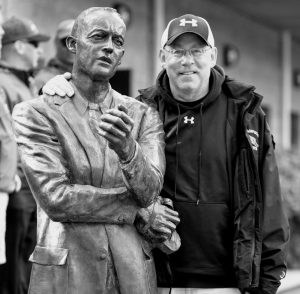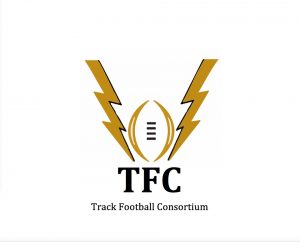
Breakfast With Korfist
I try to meet Chris Korfist for breakfast about once a month. We meet at Patti’s Sunrise Cafe in Burr Ridge. We always sit in the same booth (southeast corner).
It was at Patti’s Sunrise Cafe back in 2014 that Chris and I discussed track clinics of the midwest. The two of us had given presentations at all of them, but rarely were we invited back. For most track clinics, the modus operandi was *one and done*. No matter how good your presentations, clinics seemed choose a new, never-before-seen speaker over the people who consistently had the best information. Chris said, “Maybe we should start our own clinic.” On that day, four years ago, the Track Football Consortium was born. Instead of a “one and done” approach, we would develop a core of outstanding presenters.
We schedule breakfast to plan upcoming Track Football Consortiums but we usually get sidetracked. Sometimes business takes up a only small fraction of our conversation.
We last met on Columbus day.
We talked about the podcast I had just listened to, Eyes Wide Open Part 1 (there’s also a part 2). I’m starting to think sleep might be the most important fundamental of sprint training. Chris didn’t need to hear the podcast I’d listened to because he’d listened to the two-hour Joe Rogan podcast on sleep. If sprinting is CNS-driven, you can’t overstate the importance of sleep. After all, cats sleep twenty hours a day.
We talked about Chris and his daughter attending the recent Fleetwood Mac concert and our common interest in the band before Stevie Nicks and Lindsey Buckingham arrived (pre-1975). I told Chris I had tickets to see Chris Knight at Fitzgerald’s in Berwyn. Chris highly recommended the new album by Joe Bonamassa (Redemption) and Paul McCartney (Egypt Station).
Chris told me that he had finished a book recommendation of mine, Rebel Yell: The Violence, Passion, and Redemption of Stonewall Jackson, by S.C. Gwynn. We had both read Gwynn’s award-winning Empire of the Summer Moon. I’m presently in the late stages of a 1000-page novel by Ken Follett, A Column of Fire (16th Century Elizabethan England, Protestants vs Catholics, the defeat of the Spanish Armada, etc.)
We don’t talk politics but Chris often tells me that he’s going to turn me into a capitalist.
Chris told me about the book he’s writing with Cal Dietz, Integrated Sprint Training. We discussed my book idea, In Search of Rebel Talent. Chris likes the title. (Obviously, Chris Korfist would be one of my subjects.)
I told Chris about the 15 hours I spent over the weekend making a DVD for Championship Productions.
We talked about how hard it was for a coach to watch your own kids go through bad high school programs. We discussed the negatives of youth football and how high school football numbers are dwindling as the result.
I informed Chris I was speaking at the 2019 Complete Speed and Power Summit in Trintin, NJ. Chris gave me a bucket list of places in New York that I should visit.
We talked about the 8-0 Montini football team (outscoring opponents 299-50) and how their athleticism would translate to track excellence in the spring.
Chris told me about the recent RPR Clinics that sold out in Taiwan and the videos that will need a Chinese translator.
We shared stories of the maddening demands placed on today’s teachers. Teaching gets 2% worse every year. It never gets better.
Then we finally got around to talking about speed.
Chris is excited about the possibilities of Exogen compression tights and microdosing loads. The idea is to get stronger doing sprint-specific work as opposed to lifting weights. We talked about how weight lifting improves strength that seldom applies to faster sprinting. I repeated the stuff I say in my presentations. Weight lifting impacts blood-fed red muscle fibers that are aerobic and slow-twitch. Sprinters are fast due to near-bloodless fast-twitch anaerobic muscle fibers. Weight lifting improves the strength and size of slow twitch fibers, good for pushing a car up a hill, not so good for sprinting. That’s when Chris added something about muscle relaxation. When we sprint, our muscles quickly contract and then relax, then the cycle repeats over and over again. The weight room is all about contraction, and not necessary a quick contraction. Concentric contraction happens and then the contracted muscle elongates (eccentric). Nothing in the weight room works on the rhythmic cycle of contract-relax at a fraction of a second. Nothing in the weight room works on the symphony of a sprinter’s muscles working together as they contract and relax. This is why weight room strength and sprinting strength are two different things. Epiphany.
Chris Korfist has strong data to show the value over-speed training using the 1080 Sprint. I believe the symphony of muscles contracting and relaxing at lightning speeds with perfect timing also explains the need for over-speed training. When the 1080 pulls a sprinter, the sprinter must increase the frequency of the contract and relax cycle.
My overspeed training system is more earthy. We love to train on windy days. High wind is the perfect over-speed workout. Once again, running with the wind increases the frequency of the contract and relax cycle. My friend, John Hunter, and I have discussed building a wind tunnel for training. Chris Korfist thinks we’re crazy. Anything that teaches the CNS to fire quickly AND is sprint-specific makes sense to me.
I told Chris about Michael Papper (Loyola University) running a 0.91 ten-meter fly for me on Sunday. I asked Chris to show me the “toe curls” that made a huge impact on Michael’s speed. Chris took off his shoe, bent his big toe upward and showed me the drill. I have no idea what the rest of the people eating at Patti’s Sunrise Cafe thought of our conversation. We were too far down the rabbit hole to care.
As our 90 minutes was nearing a close, I asked Chris to tell me for the tenth time what to do about a sprinter whose steps cross the mid-line. (I don’t know why I need to so many repetitions to learn new things!). The answer: “glute med and big toe”. Hip hikes from neutral using a Swiss Ball and the aforementioned toe curls and Bosch Drills. Its all about the foot-hip connection.
Breakfast was great but I don’t remember what I ate.
Tony Holler
@pntrack



When I “ran” (well, walk-ran) ultras, I got piriformis sciatica (butt pain) that prevented running after 30 miles. A 75-year-old gym coach told me to do slow, rhythmic reps on the leg-press machine. He said, “After three reps you’re gonna hate me.” He was right. I was in my 50s at the time and worked up to 12×650 (it was enough). The sciatica went away and my legs became absolutely tireless. But I got NO FASTER. Later, in my late sixties when I started deadlifting and uphill sprinting, I could sprint harder with vim and gusto and go faster. Pretty sure it was the uphill sprints. Now at 76 I ride the bike and try not to think about age-related speed decline. “You lose a lot of speed between 80 and 90.” – Ruth Rothfarb
Where would one find a more detailed description of the “toe curls” you mention?